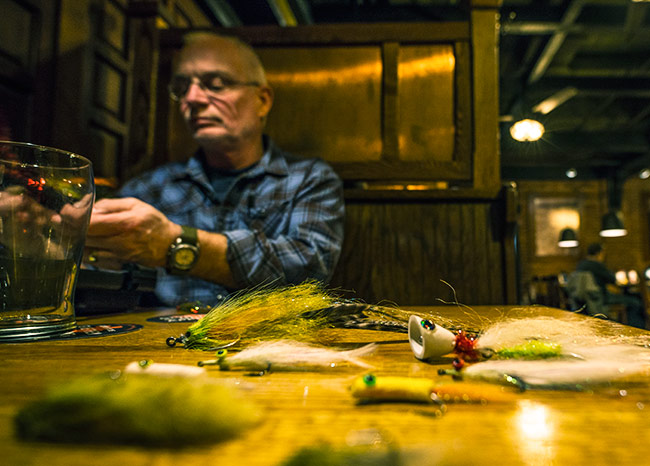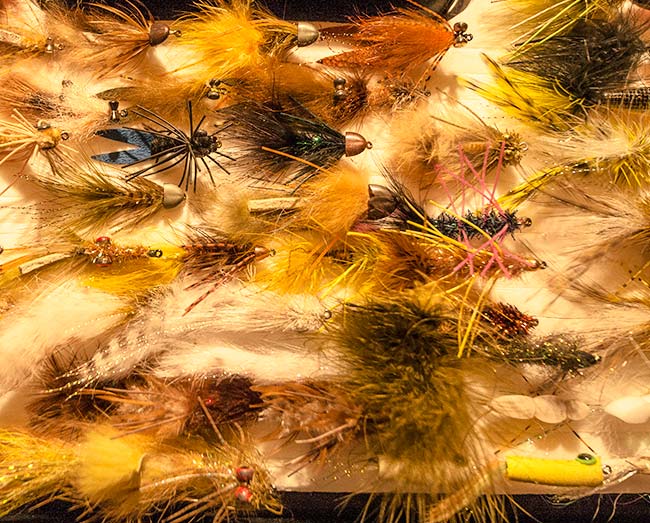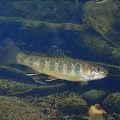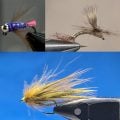Inside the Box: Jerry Darkes
Last week I sat down with author, guide and lifelong big water angler Jerry Darkes. Over a few beers at my favorite pub we talked about the tens of thousands of miles of North American freshwater shoreline neglected by fly anglers, why that is and how things might change. By the time the interview was over, I had a few new flies and even more fly ideas. Most importantly, my 2016 fishing itinerary had gotten a lot more exciting.
MC: Let’s start with your book, Fly Fishing the Inland Oceans. How did it come about?
JD: Fly Fishing the Inland Oceans is basically my Ph. D. thesis, the product of 30 years of fly fishing the Great Lakes. This is not tributary stuff. This is near shore and connecting waters—things like that. And there’s plenty of that type of water. If we’re talking just the Great Lakes, the stats are something like 11,000 miles of shoreline. And while the book focuses on the Great Lakes specifically, it’s part of a larger, growing conversation about big inland lakes everywhere, whether that’s western or southern reservoirs, Midwestern basin lakes or the huge glacial lakes of the Canadian Shield. Near-shore freshwater fishing is a tremendously neglected aspect of our sport. We talk a lot about salt water flats fishing, we talk a lot about about stream fishing, but big lake fishing is not something that gets as much publicity as it could and should.
MC: What do you like about big water fishing?
JD: First, big lakes are dynamic places with a lot of different target species. And lake fishing is quite varied. Most of it equates very well to salt water fishing. Sometimes you’re throwing at selective spooky fish cruising the flats. But then there times when you’re blind-casting giant flies for apex predators. And everything in between. That’s what makes it so cool. And because lakes are such complex ecosystems, sometimes you have days you just didn’t expect. One of the coolest big water experiences I’ve had was last June on Michigan’s Lake St. Clair with guide Brian Mezaros. We launched up at the north end of the lake. It was dead-flat calm, hazy. We’re running out to spot muskies, but on the way out we keep seeing swirls. We stop and look, and it was one of the first days that the hex started coming off—don’t forget that lakes get hatches, too. In any case, these were very large smallmouth coming up and eating mayflies. We didn’t have any hex imitations so we threw little poppers and for the whole afternoon caught 3-5 smallmouth that came up and sipped just like brown trout. We never got to musky fishing that day. That’s big water for you: dynamic, unexpected. Opportunities are everywhere. Sometimes they’re the ones you expect, sometimes they’re the surprises.
The second reason big water fishing is so cool is that it’s relatively untouched and unexplored by fly anglers. In the case of the Great Lakes, I’d say there’s less than 100 guys that fish them on a regular basis with a fly. Sure, there are guys that will run down and throw a line. But if we’re talking about guys that really focus on the Great Lakes and fish it regularly or exclusively with a fly rod, trying to figure it out and pick it apart, it’s probably less than 100. And it’s not because they can’t catch fish. They catch phenomenal fish. It’s because they can’t get their customers to believe they can catch fish in big water, because they haven’t seen it in a video or in a magazine yet. It had be hard to convince clients to try new things, especially those with a finite number of days to fish each year.
MC: Why do you think that is?
JD: There’s a lot of tunnel vision. We’re all guilty of it at times. We have a tendency not to do things that are uncomfortable to us, a tendency not to really stretch our approach and attitude. Part of it is the fear that, “Oh, I might fail. I might not catch something if I try something new.” But of course there are plenty of times that you stay in your comfort zone and still fail. In those cases, you’re writing it off to, “It was a bad day.” Just keep that in mind that the next time you stay in your comfort zone and get skunked, you could have invested that time in learning something new, something that might, one day, give you one of the best fishing experiences of your life.
MC: OK. So what’s the opposite of tunnel vision look like?
JD: Well, there’s lake trout and brown trout, striped bass and white bass, smallmouth, pike and muskies to be had. And if we really want to pop the lid off things, there’s even weirder stuff. For instance, I’ve been down on the mouth of the Detroit river where it empties into Lake Erie. In the winter we sometimes go up in the shallows where there’s some warm water discharges and have incredible fishing for drum. Ever caught one on the fly?
MC: Never.
JD: Oh man. They will just kick your butt. We’ve caught them up in 2, 3 feet of water. They’re in there busting bait and stuff. Everybody thinks a sheep head is a junk fish eating trash off the bottom. No, man. They’re predatory. They’ll chase down bait and really get after it. On the other hand, we fish them sometimes off of downtown Cleveland. We’ll find them suspended over 30 feet of water. They’ll be up eating shiners ten feet under the surface. Count the fly down, start stripping it, and boom: fish on.
I even know a couple guys out of the Milwaukee area that will go down to where the Fox River dumps into Green Bay and swing flies for drum. When you crack the top open a little farther than normal, interesting things can happen.
MC: It makes me wonder what other unconventional fishing opportunities are out there for anglers willing to look a little outside their comfort zone. Now you’ve got me thinking. A fish I used to catch from time to time as a kid was a bowfin, though of course we called them dogfish. What I remember is you could have a titanium spinner bait that was designed never to get bent, but a dog fish would just destroy it. It would appear I’ve got a new goal for 2016: bowfin on the fly.
JD: There are these and many other opportunities. Who knows—big lake fishing may be fly fishing’s final frontier. And it’s there for the taking.
MC: What changes have you noticed in approaches to big water fishing over those 30 years of research?
JD: Probably the biggest thing that happened in my lifetime is the advancement in sinking fly lines. When I started doing this thirty years ago, we said, “Let’s try shooting heads with Amnesia.” It was taking your life in your hands. You had to duck every cast to make sure you didn’t wrap your line around your neck. The lines we have now are just very precise fishing tools. That’s the way I would describe them. There’s nothing random about fishing a sinking line. With a minimal amount of experience, you know where your fly is at all the time, whether you can see the fly or not. Especially in still water, we know the sink rates of the lines. And if you know the depth range you’re trying to reach, a little simple math puts you right in the area. We’re delivering the package right where it needs to go. It’s a very precise tool if you think about it in that sense.
MC: Talk us through your fly box.
JD: On one side of the box here, we’ve got a lot of creepy crawly stuff, carpy kinds of things. In general, carp flies don’t necessarily imitate anything specifically. Carp have a very highly developed sensory system, but not the best eyesight in the world. They’re probably as tough a fish to catch as any on a fly, consistently. One of the things with carp, you’ve got to get them in the right mood.
One fly that works great for carp in smaller sizes and smallmouth in larger sizes is the Clawdad. These come were originated by Chuck Kraft in Virginia. It’s basically fly fishing’s answer to the jig ‘n pig. Great fly. Fish eat it on the drop and you can work it on the bottom. In my experience, some of the more realistic looking crayfish patterns are not the best fish-catching ones. They have a lot of stiff materials in them. For lake fishing, you want materials that have good movement to them even when the water is totally still. Clawdads look good even when they’re sitting on the bottom.
MC: What would be your best all-around pattern?
JD: That would be a chartreuse half and half—basically a Clouser with saddle feathers replacing the bucktail on the bottom half of the fly. A little different action to them. That’s been my best walleye pattern right there. Also a rabbit strip Clouser. I think those would be two key patterns there. Chartreuse and white is hard to beat anywhere you’ve got big water.
MC: Let’s talk about some of these bigger flies here.
JD: A lot of these are tied with Icelandic sheep. You can fish this slow or fast. It’s just awesome and live in the water. Rabbit strips tails are great when they’re just a few inches long, but you don’t want to cast eight or ten inches of rabbit strip. Did that in the past. Don’t do it anymore. Icelandic sheep compresses down to nothing and it’s got great movement in water.
MC: I’m seeing some larger, articulated poppers, too.
JD: I’d say it’s a pike and musky fly but we get plenty of big largemouth and smallmouth on it as well. Originally these articulated surface chuggers were striper flies. Again, you’re seeing this crossover of tweaking a lot of saltwater stuff for a different situation, for freshwater tackle. They are also very castable flies, which can be important in fishing clear water: longer casts are fishier casts. It makes a lot of noise but it has a lot of movement to it. There have been days when we were out in the middle of July, early August, and caught open-water fish on a big chugging top waters. In a lake, you can get fish to come off the bottom in 10, 12 feet of water.
Then there are the wiggle minnows. You fish them on a sinking line. It’s a little like throwing a crank bait. To be honest with you, these things should be illegal. They have a great action. And they’re easy to modify with the foam body: grab some markers, you have a lot of control over what fish you want to represent. They’re deadly. Both of these are chewed-up.
MC: Maybe you can leave us a recommendation on a place to fish.
JD: Sure. The Niagara River, connecting Lake Erie and Lake Ontario, is definitely one of the most unique fishing places in the Great Lakes, just because of the massive amount of water that is flowing through there. I spent about two and a half days there in early December. There’s a big shallow reef called the Niagara Bar at the mouth of the river. We stripped flies for lakers and browns, caught a bunch of fish, then we went into the river and swung flies for steelhead. It’s a fantastic warm-water fishery in the summertime, too. And best of all? It’s totally overlooked.














